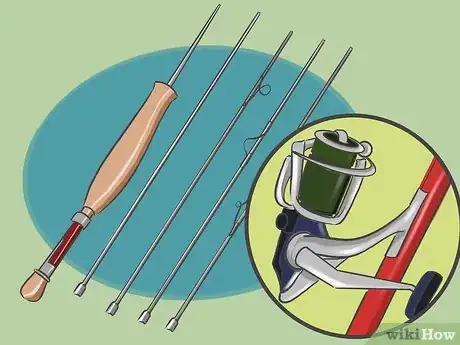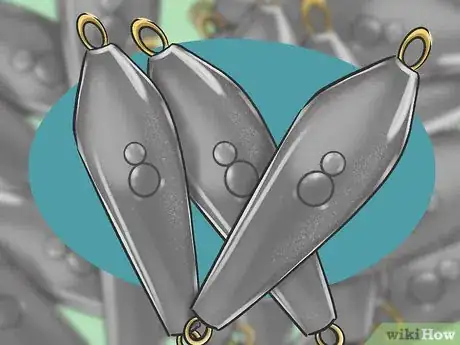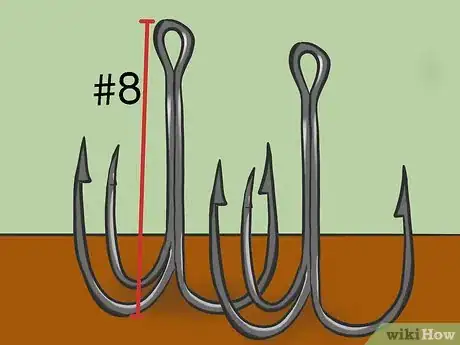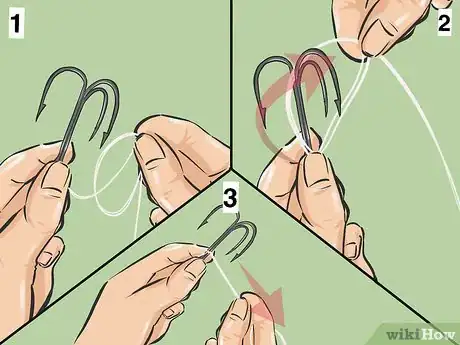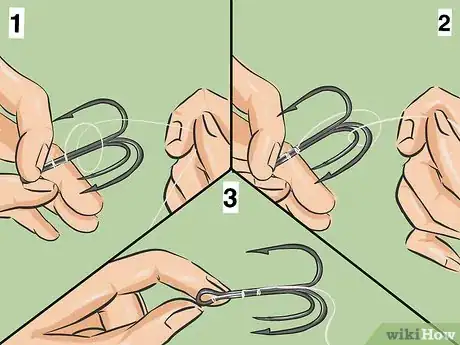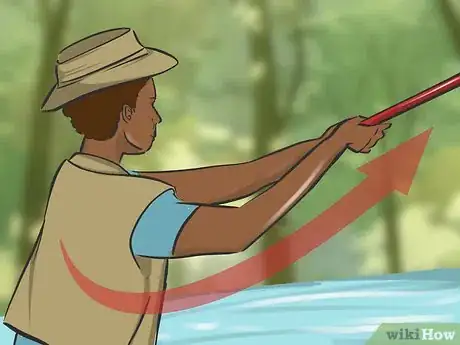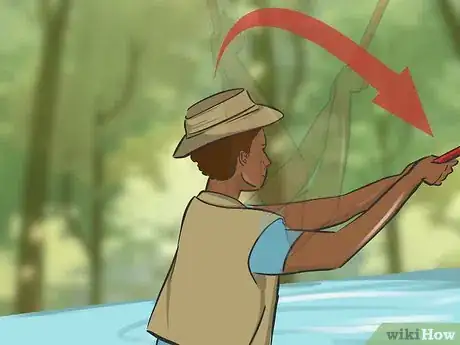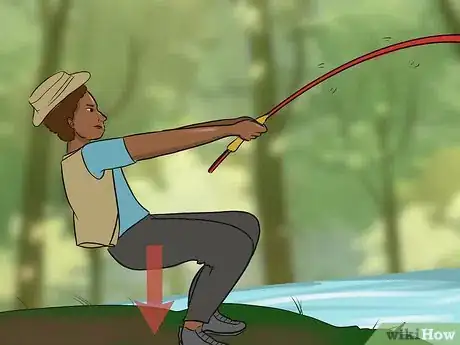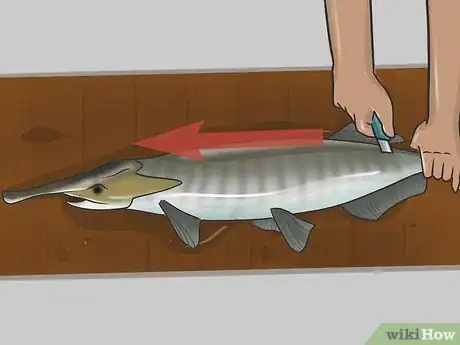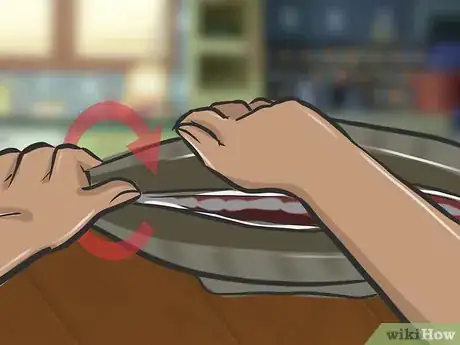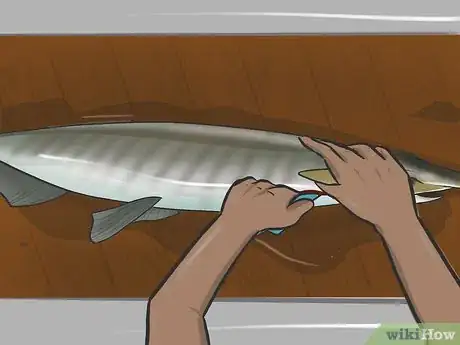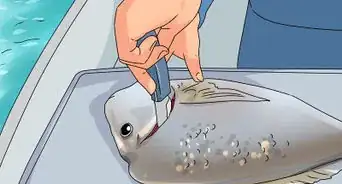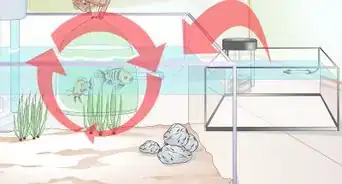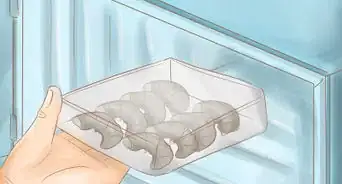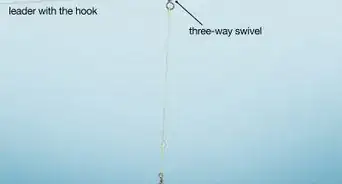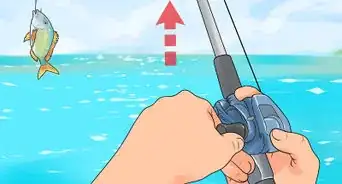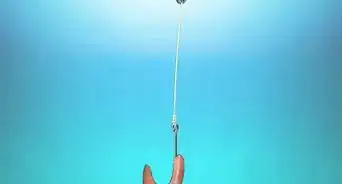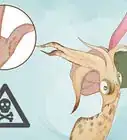This article was co-authored by wikiHow Staff. Our trained team of editors and researchers validate articles for accuracy and comprehensiveness. wikiHow's Content Management Team carefully monitors the work from our editorial staff to ensure that each article is backed by trusted research and meets our high quality standards.
This article has been viewed 19,740 times.
Learn more...
As one of the largest freshwater fish in the United States, paddlefish are an extremely exciting catch. Because these bottom feeders can weigh over 100 pounds (45 kg), many anglers look forward to paddlefish season. After learning about the necessary equipment and practicing the proper technique for catching paddlefish, you'll be prepared to snag one of these prehistoric fish.
Steps
Assembling Your Equipment
-
1Pick a stiff, 6–7 ft (1.8–2.1 m) rod that can withstand a hefty fish. It's standard to use this type of rod with a level wind saltwater reel.[1] You can also use a 7–9 ft (2.1–2.7 m) foot rod with large frame, large capacity spinning wheels.[2] It's important to choose a rod that is medium-heavy and stiff. Paddlefish can be huge, and you don't want your rod to break while you're catching one.
- Your rod should be spooled with 100 lb (45 kg) test braided line. If your fishing line is too delicate, it will probably break.[3] This line has to withstand a fish, multiple weights, and some heavy hooks, so choose your most resilient fishing line.
- If you find fishing line that is even heavier, go ahead and use it.
-
2Pack a dozen heavy sinker weights to weigh your line. You'll need to plan on bringing more than a few weights to catch paddlefish, since you can depend on losing a few weights in the water. Bring weights ranging from 8–16 ounces (0.23–0.45 kg).
- You'll use the heavier weights in deeper water.
Advertisement -
3Pack sturdy, heavy, #8 to #14 treble hooks. Treble hooks are unique and easy to identify because they are 3 hooks that share a single eye. You'll probably lose some hooks in the water, so stock up on at least a dozen hooks for your trip.
- You'll use heavier hooks in deeper water.
-
4Remember to pack miscellaneous tools. Leather gloves can protect your hands from chafing against the heavy rod. Needle nose pliers are a useful tool for reshaping hooks and plucking hooks from the paddlefish.[4]
- You should also take care to remember your fishing license!
Baiting Your Hook
-
1Tie an overhand knot with your line. Lie your line flat and lay one end of the line over the rest of it to form a round loop. Tuck the end of the line into the round loop and pull it out of the round loop. Thread the loop from the knot through the hole at the top of your weight. Pull it tight.
-
2Double the line and pull it through the eye of your treble hook. Take the end of your fishing line and double it up. You'll want to pull on the end of the doubled up loop. Pull on your fishing line until the end of the line is about two feet away from your weight.[5] Thread the doubled up fishing line through the hook's eye.
-
3Tighten the line on the hook. Loop some of the fishing line below the hook. Then, bring the treble points (the curved bottom of the hook) through the loop. Tighten the loop around the shank of the hook (the straight portion of the hook, between the eye and the treble points).[6] Tighten the line around the shank once again by repeating the steps above.
- Paddlefish don't swallow worms, lures, or bait, so you only have to worry about making sure your equipment is securely assembled. Also, make sure that you're using enough weight.
Snagging a Paddlefish
-
1Cast, jerk, and reel in your line to snag a paddlefish. Now that you're reading to snag, you have to get into a steady rhythm of casting your line in a sweeping motion towards yourself. Then, jerk the line out a little bit in the opposite direction.[7] Quickly reel in any extra slack on the rope.
- One of your main goals is to make sure that the line doesn’t have any extra slack in it. If your line has slack, your hook will drift through the water. When snagging, your hook should be moving precisely on a taut line instead of drifting.
-
2Perfect your snagging. Your snagging motion should be like a reverse baseball swing.[8] The widest, most sweeping movement should be towards yourself. Jerking the line out towards the water is a smaller motion.
- When you're snagging, rest every 20 minutes. The quick, steady movements can be tiring, so don’t overexert yourself.[9]
- You can snag either on a boat or from land. Either way, you'll use the same motions. When you're out in deeper water though, you'll need to weigh your line more heavily because paddlefish are bottom feeders.
-
3Reel in your fish. If you've secured your hook correctly, the line should jerk without slipping when it contacts a fish.[10] Stand with your knees shoulder length apart and pull!
- If you've hooked your fish in the head, you'll probably have an easier time reeling it in. If you've hooked your fish in the tail, you'll probably have a more intense struggle.[11] Either way, be patient!
Cleaning a Paddlefish
-
1Hang your paddlefish at a convenient height or lie it down flat. If hanging, be sure to hang the fish by its nose. You'll need to drain the blood by the tail, so you want the tail to be either facing the ground or lying on a flat surface.
-
2Begin cutting out the backbone by slicing around the tail. Cut into the fish, starting at the meat above the tail. Cut downward, towards the bottom of the fish. You’ll want to cut in a complete circle, so that you only have a single incision in the fish.[12]
-
3Grab onto the end of the tail and slowly rotate it around in a circle. The backbone will give a lot of resistance at first because it’s attached to a cartilage rich area inside of the fish. Rotate the tail back and forth until you can easily move the tail around in a circle.[13] Pull the backbone downward, out of the fish. The blood will drain from the fish through the hole you've made.[14] Watch out! The blood can get very messy.
-
4Slice fillets off of the fish. Begin your cut behind the gill cover. You’ll need to cut into the fish first, towards the cartilage rich area of the fish. Once you’ve hit the cartilage, begin slicing sideways, alongside the fish. Slice towards the tail, along the cartilage.
-
5Slice the skin off of the flesh. When you’re ready to remove the skin, prepare a clean, wooden board. Set your fillets on a board and slice the skin off of the surface of the fillets. You can remove the piece of dark meat in the middle of each fillet.[15]
Warnings
- Do not bag more fish than your state or region allows.⧼thumbs_response⧽
References
- ↑ https://huntfish.mdc.mo.gov/fishing/species/paddlefish/paddlefish-tips-fishing
- ↑ https://huntfish.mdc.mo.gov/fishing/species/paddlefish/paddlefish-tips-fishing
- ↑ https://huntfish.mdc.mo.gov/fishing/species/paddlefish/paddlefish-tips-fishing
- ↑ https://huntfish.mdc.mo.gov/fishing/species/paddlefish/paddlefish-tips-fishing
- ↑ https://www.outdoorlife.com/catch-giant-paddlefish
- ↑ https://huntfish.mdc.mo.gov/fishing/species/paddlefish/paddlefish-tips-fishing
- ↑ https://huntfish.mdc.mo.gov/fishing/species/paddlefish/paddlefish-tips-fishing
- ↑ https://rapidcityjournal.com/sports/great-outdoors/feature/south-dakota-s-strangest-fish-the-highly-sought-paddlefish/article_e5ab3370-dcd3-5639-9f69-ddbf41d08287.html
- ↑ https://www.outdoorlife.com/catch-giant-paddlefish
- ↑ https://huntfish.mdc.mo.gov/fishing/species/paddlefish/paddlefish-tips-fishing
- ↑ https://rapidcityjournal.com/sports/great-outdoors/feature/south-dakota-s-strangest-fish-the-highly-sought-paddlefish/article_e5ab3370-dcd3-5639-9f69-ddbf41d08287.html
- ↑ https://huntfish.mdc.mo.gov/fishing/species/paddlefish/paddlefish-tips-fishing
- ↑ https://huntfish.mdc.mo.gov/fishing/species/paddlefish/paddlefish-tips-fishing
- ↑ https://huntfish.mdc.mo.gov/fishing/species/paddlefish/paddlefish-tips-fishing
- ↑ https://huntfish.mdc.mo.gov/fishing/species/paddlefish/paddlefish-tips-fishing
